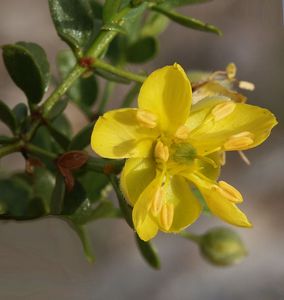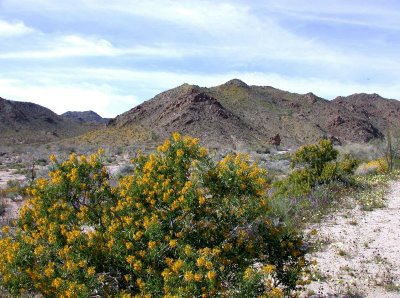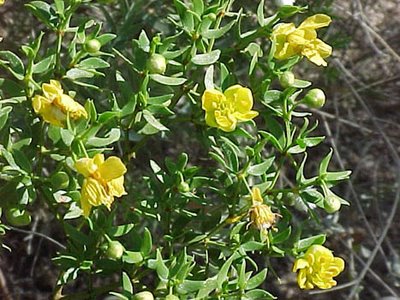Creosote Bush
Common: Creosote bush, Greasewood, Guamis
Scientific Name: Larrea tridentata
Family: Zygophyliaceae
Origin: Native to deserts of southeastern California, Arizona, southern Utah, western Texas, northern Mexico. Usually grows on dry plains, mesas and slopes, between sea level and elevations of 5,000 feet.
Sunset Zone: 10-13, 19
Light: Full sun
Soil: Sandy and poor soil types
Water: Drought tolerant. Taller, denser growth with water
Creosote, Death Valley Dunes The oldest living thing on earth is a flowering shrub called the creosote bush, found in the Mojave Desert. It is 15 metres (50 ft) in diameter. It is estimated that it started from a seed nearly 12,000 years ago.
During its lifetime the last major period of glaciation in North America came to an end, the wheel and writing were invented, and the great Egyptian and Mayan pyramids were built. The shrub is still living.
The creosote bush (Larrea tridentata) is common in the Desert Southwest. The creosote bush can be identified from its waxy green leaves and yellow flowers. These later turn to round, white wooly seed-vessels, which are the fruit of the creosote bush. In Arizona it is only found in the southern third of the state because it cannot exist above 5,000 feet of elevation. In the Phoenix area, it is the dominant desert shrub.
Many people who are new to the desert notice the peculiar odor in the desert on the rare occasions when we have rain. People who move to the Phoenix area look at each other and ask, “What is that smell?” It is the creosote bush. It is a very unique odor, and although many people don’t care for it, some seem to like it just because it conveys a positive message – RAIN! The leaves of the creosote bush are coated with a resin to prevent water loss in the hot desert. The resin of the creosote bush also protects the plant from being eaten by most mammals and insects. It is believed that the bush produces a toxic substance to keep other nearby plants from growing.

Creosote bushes are very long lived, many of them existing for one hundred years, and can grow to a height of 15 feet. There is one living creosote bush that is estimated to be nearly 12000 years old! Although some refer to the odor of the crushed leaves as the “heavenly essence of the desert,” the Spanish word for the plant, hediondilla, means “little stinker“, signifying that not everyone considers the odor heavenly or pleasing to the senses.
The creosote plant was a virtual pharmacy for Native Americans and the steam from the leaves was inhaled to relieve congestion. It was also used in the form of a medicinal tea to cure such ailments as flu, stomach cramps, cancer, coughs, colds, and others.










0 Comments:
Post a Comment
<< Home